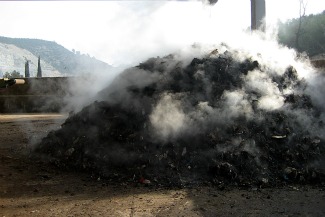What to do with the organic waste generated daily?

Our daily activities inevitably lead to waste generation. Specifically, each person generates around 1.6 kg of waste per day, of which 500 g corresponds to organic matter. This organic matter (food scraps and garden waste) can be valorised using different treatment technologies, mainly anaerobic digestion and / or composting. The final product obtained, called compost, can be used as an organic amendment in agriculture. This valorisation process is positive and necessary; however as any industrial process it leads to some environmental impacts that must be studied and characterized. The information on the generated environmental impacts can be used as a decision-making tool on the best technology to treat our waste.
The article “Determination of the energy and environmental burdens associated with the biological treatment of source-separated Municipal Solid Wastes” published in Energy and Environmental Sciences by researchers from the Composting Research Group at the Chemical Engineering Department analyses different biological treatment technologies of the Organic Fraction of Municipal Solid Waste (OFMSW). The study is based on the environmental impacts generated by four different waste treatment plants each of them using a different technology . The impacts of the home composting process are also determined, as a process that is gaining importance and that can be helpful in improving household wastes management.
The study can be divided into three parts. The first part corresponds to the completion of the inventory, i.e. the collection of data from measurements in a real plant, the calculation and the presentation of impacts for each technology. For example, water and energy consumption, emissions to the atmosphere of gases such as methane, ammonia, nitrous oxide or Volatile Organic Compounds (VOCs) or the generation of leachates have been determined. This part of the work allowed us to define an inventory based on local data to be used in future studies. The results indicate that the total energy consumption in OFMSW biological treatment plants varies between 235 and 870 MJ / t OFMSW treated. Regarding atmospheric emissions the following ranges were determined: 0.36-6.2 kg VOC, 0.23-8.63 kg NH3, CH4 and 0.34 to 4.37 kg 0.035-0.251 kg N2O, always refer to 1 t OFMSW treated.
In a second phase the Life Cycle Analysis (LCA) of each process was determined on the basis of one tonne of waste treated as functional unit (value to which all impacts are referred). But the most important contribution of the research relates to the third part of the study with the proposal of a new functional unit that allows real comparison between treatment technologies. Since the main objective of OFMSW treatment plants is to stabilise the organic matter content of the waste to a level that allows its use as compost, the quality of the compost should be taken into account in LCA studies. In this sense, the quality of the final compost obtained and the degree of stabilisation achieved are included in the functional unit. Compost quality is measured by means of the Dynamic Respiration Index (DRI). The Composting Research Group is a leader in the development of this parameter. The DRI is used to measure the aerobic biological activity of an organic material. It is based on the measurement of oxygen consumption rate. High oxygen consumption rates are indicative of materials with a high content of biodegradable organic matter, whereas a low consumption corresponds to stable materials, i.e. materials that can hardly suffer subsequent biological degradation. Good quality compost should present a DRI value lower than 1 g O2 / kg Organic Matt. h, while the OFMSW may present DRI values close to 5 g O2 / kg Organic Matt. h. This new functional unit can also be used to determine whether biological stabilisation process (anaerobic digestion or composting) in a particular facility is being carried out in an efficient way or not, and therefore, could be used for the evaluation of organic waste biological treatment facilities.
References
Joan Colón, Erasmo Cadena, Michele Pognani, Raquel Barrena, Antoni Sánchez, Xavier Font and Adriana Artola.
Determination of the energy and environmental burdens associated with the biological treatment of source-separated Municipal Solid Wastes
Energy Environ. Sci., 2012, 5, 5731-5741


